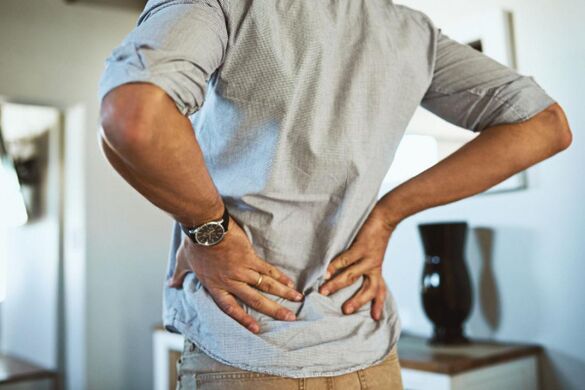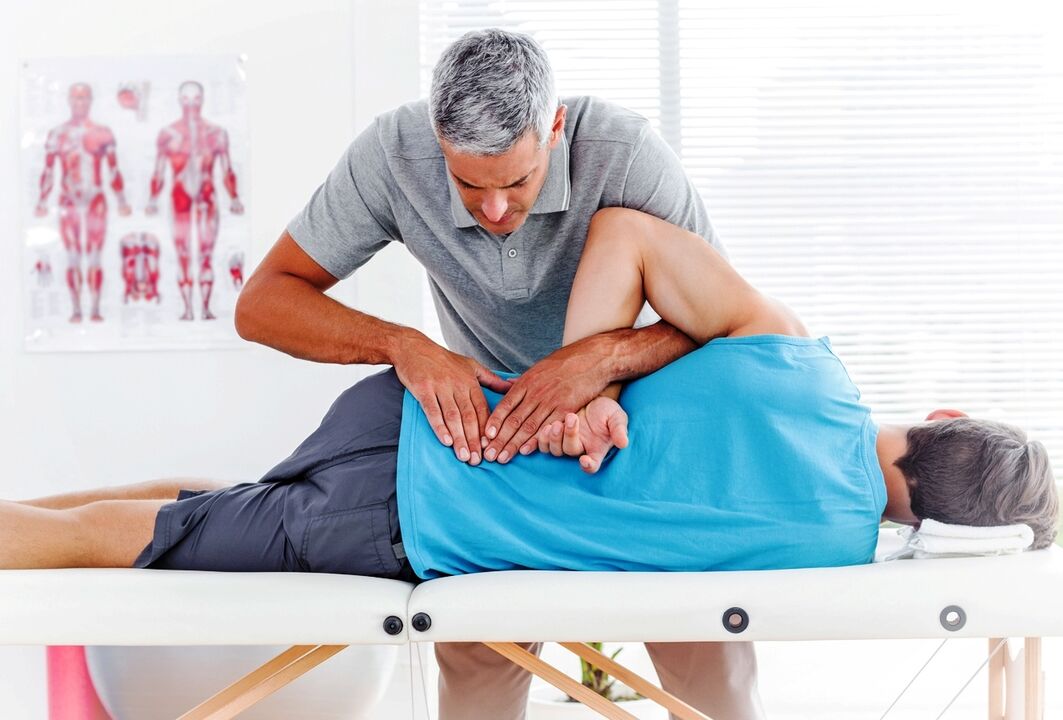
Lowe's painIt shows disease or damage to the spine, nerve structures, soft tissues, internal organs are observed in feverish conditions of different genesis.He is sharp, stupid, constant, periodic, burning, shooting, cracking.Sometimes it is associated with physical activity, changes in time.Pathologies manifested by lower back pain are diagnosed on the basis of complaints, history, examination data and additional studies: radiography, MRI, CT.Before making a diagnosis, peace is necessary, sometimes it is permissible to use ointments, to take analgesics.
Why does the lower back hurt
Spinal diseases
A common cause of lower back pain is congenital abnormalities and acquired diseases of the spine.The nature of the pain syndrome varies.The pain caused directly by the pathological process, often periodic, local, sick or pulling, is associated with time, physical activity, remain in an uncomfortable position.
Due to the spasm of the muscles, lumbago (laterally) occurs-acute pain, accompanied by restriction of movement.With many pathologies of the spine, lumbojishialgia is observed - pain, burning or firewood radiating on the back of the thigh.Painful sensations are often found in radicular syndrome.Can be found in the following diseases of the spine:
- Degenerative pathologies: Osteochondrosis, protrusion of the intervertebral disc, intervertebral hernia, spondylosis, spondylo arthrosis.
- Congenital anomalies: Sacralization, lumbarization.
- Polyethological conditions: spondylolis, spondylolist.
- Vascular disease: Disorders of spinal circulation.
- Other diseases: Forearm disease.
- Secondary lesions of nerve structures: lumbosacral radiculitis, lumbosacral plexitis, myelopathy of different genesis.

Spine curvature
For all types of spinal curvature, insignificant or moderate pain is observed, which are associated with non -violet redistribution of the load, overvoltage of the muscles and backs on the back.The soreness occurs as a result of the uncomfortable position of the body, sleeping on a too strong or too soft bed.The symptom is accompanied by:
- Lordosis;
- kyphosis;
- scoliosis;
- Kyphoscoliosis;
- Flat back syndrome.
Osteoporosis
Pulling or painful painful sensations in the lumbar and thoracic spine for a long time are the only symptom of osteoporosis.Pain syndrome is explicitly expressed, exacerbated after loading before changing the weather conditions.The symptom is observed in the following varieties of osteoporosis:
- postmenopause;
- Minor;
- Idiopathic;
- Senile.
Such pain is detected in patients with secondary forms of pathology due to genetic diseases, endocrine disorders, chronic intoxication and administration of certain medicines.Secondary osteoporosis can also occur against the background of malabsorption syndrome, liver disease, KHPN, rheumatoid arthritis, well.
Strengthening the pain, an increase in the duration of pain can be associated with the development of a pathological fracture.Other signs of trauma are often not expressed, so the fracture often remains undiagnosed.
Spine injuries
The most common damage is the bruising of the spine.In mild cases, pathology is manifested by moderate pain in the lower back, increased during movements, local edema and sometimes hematomas and hemorrhages.In severe bruising, neurological disorders are added to the symptoms listed.
The breakage of compression of the lumbar spine occurs due to the violent flexion of the body.It is characterized by acute pain, retaining breathing at the time of injury.Then there is an increase in pain in the case of corpus turns, edema of soft tissues is detected.The palpation of the spinous process is painful.Other possible fractures include damage to arcs, transverse processes, spear processes.
In addition, lower back pain is detected in patients with traumatic spondylolists and subluxation of the vertebrae.The painful sensations are paroxysmal, resembling lumbago, complemented by a feeling of heaviness and numbness of the lower limbs.
Soft tissue injuries and kidneys
Soft tissue injury is accompanied by a minor or moderately quickly subsided local pain, a small edema.Hemorrhages are possible.There is no blood in the urine.Kidney bruises are manifested by pain and insignificant short -term hematuria.In the case of kidney injuries, the painful syndrome is intense, the pain radiates to the lower abdomen, groin and genitals.A hematoma is visible in the lumbar region.In severe cases, severe pain is observed, prolonged macro -hematuria is observed.The state of shock is developing.
Spinal cord infections and spinal cord
The osteomyelitis of the spine can be hematogenous, post -traumatic, contact, postoperative.The acute form of the disease is manifested by a rapid increase in lower back pain, combined with chills, fever, intoxication syndrome and worsening in general condition.The pain that trembles, burst, so intense that it prevents any movement, forces the patient to freeze in bed.In chronic osteomyelitis, the manifestations are smoothed, a fistid course with purulent divided is formed.
Spinal tuberculosis develops gradually.Initially, periodic deep pain, increased after loading, increased sensitivity of the skin in the projection of the affected vertebrae, is observed.The connectivity of the gait is formed.Against the background of significant destruction of bone structures, the nature of the pain changes as it is caused by the compression of nerve roots.The pain becomes burning, radiated to the legs, complemented by paresthesia, numbness.
In patients with spinal epidural abscess, the pain is severe, deep, poured, combined with chills, hyperthermia, muscle tension.The adhesion of the spinous processes of the vertebrae is painful.With the progression of the pathology, rooster syndrome occurs, then paresis, pelvic disorders develop.
Local inflammatory processes
The thunder processes in the surface tissues and close to the fiber are accompanied by intense pain in the lower back.Possible causes of pain syndrome are boils, carbohydrates and paranephritis.
In the first two cases, the abscess is formed in the skin, looks like a limited, sharply painful seal with a diameter of 1 cm purple or purple-blue with one or more rods in the center.The pain increases rapidly, becomes trembling, throbbing, loses sleep.General hyperthermia, minor or moderate violation of the common state is noted.
With paranephritis, a distinct fever appears initially.Pain syndrome develops after 2-3 days.The pain is very intense, can be given to the stomach or hypochondrium, enhanced when walking, movements, deep breathing.In some forms of paranephritis due to pain, the patient occupies a forced position.The lumbar muscles are tense.Edema, local hyperemia, hyperthermia are detected.The condition is serious.
Infectious diseases
Diffuse lower back pain, causing a desire to change the position of the body, are characteristic of acute infections, accompanied by fever and intoxication syndrome.In most cases, they are due to myositis, often combined with pain in the muscles of the limbs.Observed with influenza, tonsillitis, acute respiratory viral infections.Sometimes the pain is provoked by damage to the kidneys.Infectious diseases, accompanied by pain in the lower back, include:
- hemorrhagic fever;
- Japanese mosquito encephalitis;
- Ebola fever;
- leg and mouth disease;
- severe coronavirus infection;
- Generalized forms of bacterial, fungal, viral infections.
In many patients, lower back pain is observed in cytokine storm - an inflammatory reaction that develops against the background of severe infectious diseases.Epidemiological myalgia is accompanied by intense paroxysmal pain up to 10 minutes, which appear not only in the lower back, but also in other parts of the back, in the abdominal wall, chest, limbs.Repeat at an interval of 30-60 minutes.In combination with rhinitis, conjunctivitis, severe hyperthermia.
Other muscle lesions
The diseased pain in the lumbar region muscles is determined after intense physical activity - the performance of exercise exercises for the back muscles, a long stay in the forced position with a tense lower back.Myalgia disappears at rest, increases during movements, weakens after warming, pure warm -Up, disappears in a few days.
Myositis develops not only with infectious diseases, but also after hypothermia or overload, against the background of exogenous intoxication, metabolic disorders.Accompanied by long -term sick pain.There are also special forms of myositis:
- specific infectious myositis for syphilis and tuberculosis;
- Idiopathic, juvenile dermatomyositis and polymyositis;
- Polymyositis and dermatomyositis for oncological pathologies, systemic connective tissue diseases.
Chronic diffuse pain throughout the body, including the lower back, are observed with fibromyalgia.They are combined with sleep disorders, asthenia, neurotic disorders.
Other diseases
In addition to the listed pathologies of the lower back, they can deal with such conditions as:
- Spinal tumor, spinal cord: Sarcoma, hemangioma, metastases, intramedular and extragrarian neoplasms of the spinal cord.
- Kidney disease: pyelonephritis, glomerulonephritis, urolithiasis, renal heart attack, renal vein thrombosis, kidney cyst, kidney cancer, purulent processes.
- Hereditary: hereditary brain ataxia Pierre-Marie.
- Exogenous intoxics: Abuse of phenylpropanolamine.
- Pathologies of the heart and blood vessels: Endocarditis Lefler, abdominal aortic aneurysm.
- Emergency: Hemotransfusion shock.
The pelvic disease is sometimes sometimes noted the irradiation of pain in the lower back.The onset of a symptom is possible in a number of female diseases, prostate cancer, projection, sigmoid.
Diagnostics
Primary diagnostics are performed by an orthopedic traumatologist.In the presence of neurological symptoms of the patient, the neurologist examines.The doctor interviews the patient, performs an objective examination.According to the testimony, consultations of a surgeon, rheumatologist, urologist and other specialists are appointed.The diagnostic program may include:
- Neurological examination.In the course of the study, the specialist evaluates reflexes, muscle strength, movement coordination, deep and surface sensitivity.
- X -ray.In terms of radiographs of the lumbar department, fractures are visible, reduction of the height of the intervertebral discs, other degenerative changes, volume formations, signs of inflammatory processes and spondylolistration.If necessary, standard radiographs are supplemented by functional studies.
- Other neurusual methodsSCT and MRI are used to clarify radiography data.During computed tomography, the structure of solid structures is studied in detail, the status of the ligaments and the intervertebral discs is examined on MRI.Myelography is performed to exclude stenosis.
- Functional studiesSThe condition of the muscles and the nerve conductivity is evaluated by electromyography, electroneiography and studies of the caused potentials.
- Laboratory testsSIn order to confirm the infectious nature of the disease, the determination of the pathogen conducts blood tests and microbiological examination.Serological reactions are used to detect neuroinfection.

According to the indications, ultrasound of the kidneys, prostates, pelvic organs, urine tests, abdominal aorta, other studies and other studies are performed.
Treatment of pain in the line
Aid to Stage of Proceedings
In the case of traumatic spinal damage, it is necessary to place the patient on the shield and to immediately deliver to the medical institution.In case of non -human pain, it is necessary to reduce the load on the back, to optimize the position of the body during work and to rest.Acute pain syndrome is an indication of consultation with a neurologist.
A single intake of analgesics is possible before the expert examination.In Lumbago, lumbar -Ilgia caused by early diagnosed degenerative diseases of the spine, the use of warming and painkillers is allowed.If there is a suspicion of the presence of an infectious process, the local agents are not displayed.
Conservative therapy
The basis of treatment is physiotherapy measures and drug therapy.The patient is prescribed a protective regimen.Apply the following methods:
- NsaidSEffective in acute and chronic muscles and spine.It is used in the form of tablets, local products.
- Neurotropic vitaminsSPatients are introduced from B vitamins, which enhance the effects of drugs in other groups, help reduce pain.
- Local anestheticsSWith persistent and acute pain, therapeutic blockades with anesthetics are performed.To improve the outcome of treatment, painkillers are combined with glucocorticosteroids.
- PhyoelizationSApply ultrasound, magnetotherapy, percutaneous electrical stimulation, laser therapy, electrophoresis of the drug.It is possible to prescribe massage, manual therapy, acupuncture.
Surgical treatment
Given the characteristics of the pathology, the following surgical interventions are performed:
- Instability: Inter -Core Spondylodesis, Transpedicular Fixation, Slab Fixing.
- Tumors, osteoporosis, osteomyelitis, tuberculosis: sequestersthralctomy, vertebroplasty, kyphoplasty, corporate.
- Insurance hernia: discoctomy, microdiscectomy, nucleoplasty.
- Placement of the spinal canal: laminectomy, pansyomy, disc puncture.
In the postoperative period, analgesics, antibiotics are prescribed.Rehabilitation measures include exercises, massage, physiotherapy.



















